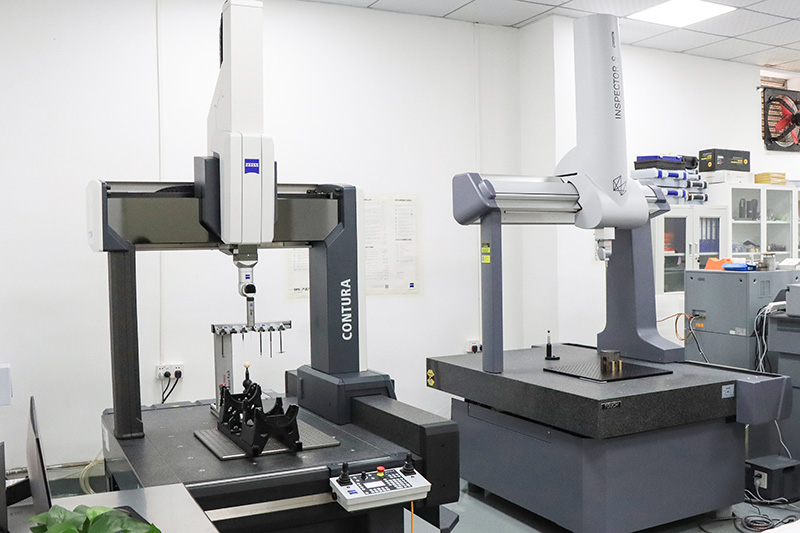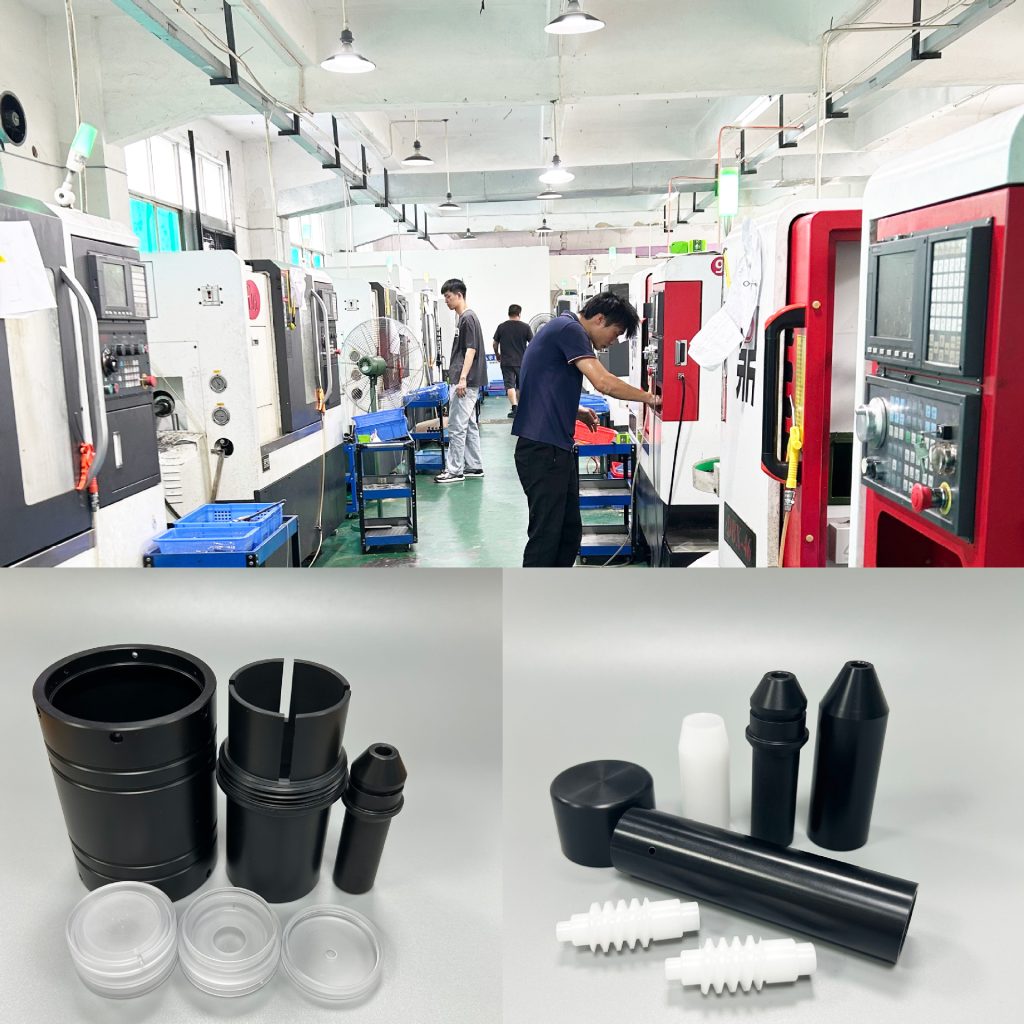ABS CNC Machining Factory Direct Services
XTJ Precision Mfg – Your Partner for ABS CNC Machining, from Prototype to Production.
- 50% Cost Savings vs US/EU
- Flexible solutions for diverse industries
- Lead Times from 5 Days for Rapid Delivery
- Tailored services to meet unique requirements

Most Common Materials for ABS CNC Machining
we offer a wide range of ABS variants alongside other plastics like Acrylic, POM, PEEK, Polycarbonate, Nylon, PTFE, PVC, and Fiberglass. ABS is chosen for its good toughness and ease of machining, with controlled cutting speeds and cooling to avoid heat softening. We recommend machine-grade ABS for optimal chip formation and surface finish.
General ABS
Our CNC expertise harnesses these traits to create parts with precise geometries and minimal defects, surpassing casting or forging in speed and accuracy for complex designs.
High-Impact ABS
Enhanced resistance at low temperatures. Perfect for outdoor applications, power tools, protective equipment.
- Get A Quote
Glass-Filled ABS
Reinforced for stiffness and heat resistance. Ideal for structural components in electronics, automotive, industrial equipment.
UV-Stabilized ABS
Resists yellowing in outdoor equipment and garden tools. Guarantees 5-year color stability.
Flame-Retardant ABS
Meets UL94 V-0 standards. Used in electronics and automotive interiors.
Heat-Resistant ABS
Withstands up to 100°C. Ideal for automotive under-hood prototypes, kitchen appliances, electronic housings.
Medical-Grade ABS
Biocompatible, FDA-compliant. Used for medical devices, laboratory equipment, pharmaceutical prototypes.
Electroplating-Grade ABS
Excellent adhesion with metal plating. Used in automotive trim, consumer electronics, plumbing fixtures.
Why Choose XTJ Precision Mfg for ABS CNC Machining?
As a leading OEM manufacturer providing one-stop manufacturing solutions
- Quality Assurance: ISO 9001:2015 certified, <0.01mm precision (down to ±0.003mm with CMM
- Advanced Technology: 120+ CNC machines, including 5-axis setups, for dimensional accuracy and design optimization, reducing production costs by up to 30%. We provide free DFM (Design for Manufacturability) feedback to optimize your designs.
- Technical Expertise: 20+ years of experience, 300+ specialists handling complex projects across 8 major industries, with NDA support for IP protection.
- Cost Efficiency: Strategic China location reduces costs by 30-40%, maintains global quality standards, offers volume-based discounts, and integrates with 200+ partner suppliers for one-stop solutions.
Top 8 Industries Using ABS CNC Machining
Discover how ABS CNC machining serves various industries with its durability, impact resistance, and cost-effectiveness. At XTJ, we specialize in custom ABS parts for these sectors, leveraging our expertise in complex geometries and diverse materials.
| Industry | Applications | ABS Benefits |
|---|---|---|
| Automotive | Dashboards, interior prototypes, bumper components, driveline spares, wheel covers, protective bumpers, steering, suspension components | Superior impact resistance, heat stability, low cost, rigidity, low weight, and shock absorbance for durable parts. |
| Consumer Electronics | Phone cases, keyboard frames, remote housings, computer keyboards, enclosures, power plugs, insulators, power-tool housings | Precise dimensional accuracy, smooth finishes, and high-impact resistance. |
| Medical | Device housings, sterilizable connectors, tool handles, drug delivery systems, compressors, lab equipment housing, pharmaceutical packaging, ultrasound equipment | Chemical-resistant, meets hygiene standards, and good heat/chemical resistance. |
| Home Appliances | Vacuum cleaner parts, refrigerator accessories, food dryers, refrigerator liners, ovens, food processors, juice presses | Scratch-resistant surfaces for everyday use and good heat/chemical resistance. |
| Industrial Tools | Power tool enclosures, equipment guards | Withstands impacts and chemical exposure. |
| Aerospace | Lightweight prototypes, non-structural components | High strength-to-weight ratio and precision. |
| Defense | Hard hats, protective headgear, defense pads | High-impact resistance and toughness |
| Food Processing | Food dryers, refrigerator liners, ovens, food processors, juice presses | Good heat and chemical resistance. |
ABS CNC Machining Process: 7 Essential Steps
- Material Selection: Choose machine-grade ABS optimized for machining, based on strength, heat resistance, and impact durability requirements.
- Design Optimization and Setup: Create precise CAD models with tolerances, tool paths, and fixturing. Secure the workpiece firmly in the CNC machine without over-compression to avoid deformation. Provide free DFM feedback from our engineers.
- Material Preparation: Cut ABS stock to size and ensure it's dry and free of moisture to prevent defects like warping.
- Machine Setup and Machining: Configure CNC parameters (spindle speed, feed rate, tooling) for ABS properties. Perform milling, turning, or drilling under controlled conditions with sharp carbide end mills or router bits to avoid heat buildup, chatter, or surface damage.
- Cooling and Monitoring: Apply non-aromatic, water-soluble coolant (as mist, jet, or liquid) to manage heat and prevent melting or defects. Use real-time monitoring for parameter adjustments.
- Part Removal and Finishing: Deburr and clean parts using precision tools for smooth edges. Inspect for quality, dimensional accuracy, and surface finish.
At XTJ, our ABS CNC machining process is optimized for precision and efficiency, using machine-grade ABS to ensure superior chip formation and surface finish. We incorporate annealing where necessary to relieve internal stresses and prevent warping.

Overcoming Common Challenges for ABS CNC Machining
ABS can warp due to heat. Solution: Optimized feed rates, coolant use, and fixturing; perform stress-relieving annealing.
Excessive heat causes melting. Solution: Monitor spindle temperatures, use appropriate tools, and adjust speeds.
Chatter or tool marks. Solution: Vibration-dampening tools, fine-tuned parameters, post-machining polishing.
Sticky chips clog tools. Solution: High-pressure coolant, chip breakers, and frequent evacuation.
Batch variations. Solution: Strict supplier controls, spectrophotometric checks.
From machining stresses. Solution: Design with radii, use low-stress grades, perform testing.
Understanding Typical Lead Times for ABS CNC Machining
Typical Lead Time: 3-7 days (from design confirmation to final part delivery), with prototypes as fast as 5 days at XTJ.
Factors Affecting Lead Time:
We provide detailed lead time estimates during quoting, with 24-48 hour quote turnaround after file submission.
How We Ensure Quality Control in ABS CNC Machining
We implement a rigorous 5-step quality control system at XTJ to prevent defects and ensure consistent results, aligned with our 99% on-time delivery rate.
- Raw Material Certification: Premium ABS from suppliers like Covestro and LG Chem. Every batch undergoes FTIR testing for purity, ensuring no impurities or moisture.
- Precision Machine Maintenance: 120+ CNC machines with weekly calibration. Temperature sensors maintain ±0.5°C accuracy to prevent ABS softening from heat.
- Real-Time Process Monitoring: IoT-enabled systems track parameters like spindle speed, feed rate, and coolant temperature. Alerts trigger if values deviate by 2%.
- First Article Inspection: Sample parts measured with CMM against CAD files before full production.
- Batch Testing Protocol: 3% of finished parts undergo mechanical testing (tensile strength ≥40MPa, impact resistance ≥200J/m per ASTM D638).
Additional: 24/7 engineering support resolves issues 3x faster, with post-production assembly, packaging, and quality checks.

ABS CNC Machining FAQ
Here are answers to some of the most common questions about CNC ABS machining, based on our expertise at XTJ Precision Manufacturing.
Excellent impact resistance, dimensional stability, chemical resistance, good strength-to-weight ratio, easy machining, attractive surface finish, cost-effective.
Automotive, electronics, consumer goods, medical devices, telecommunications, industrial equipment, defense, food processing.
±0.003mm to ±0.01mm depending on part size and complexity.
Compared to PC, ABS is more cost-effective and easier to machine but has lower heat resistance. Compared to POM, ABS offers better impact strength but lower wear resistance.
Warping from heat, surface marks, chip adhesion. ABS can yellow under UV, requires proper cooling to prevent defects.
Excellent for assembly, etching, plating; compatible with inserts.
Get Your Custom ABS Parts Today
XTJ Precision Mfg – Your Partner for ABS CNC Machining, from Prototype to Production. Upload your CAD files for a free quote in 24-48 hours.

